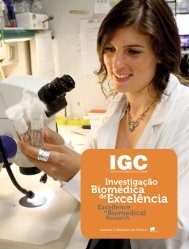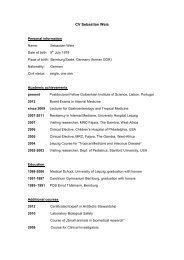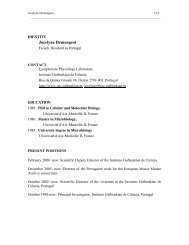organisation - the Instituto Gulbenkian de Ciência
organisation - the Instituto Gulbenkian de Ciência
organisation - the Instituto Gulbenkian de Ciência
- No tags were found...
You also want an ePaper? Increase the reach of your titles
YUMPU automatically turns print PDFs into web optimized ePapers that Google loves.
EVOLUTIONARY<br />
BIOLOGY<br />
Isabel Gordo Principal Investigator<br />
PhD in Evolutionary Biology, Edinburgh, 2002<br />
Principal Investigator at IGC since 2004<br />
link to external website<br />
All natural populations have to adapt to new environments. Knowledge of <strong>the</strong><br />
genetics of adaptation should provi<strong>de</strong> <strong>the</strong> centrepiece of a unified <strong>the</strong>ory of<br />
evolution. Despite its extreme importance, <strong>the</strong> process of adaptation is far from<br />
being un<strong>de</strong>rstood. For example: What is <strong>the</strong> rate at which positive Darwinian<br />
selection occurs? Does <strong>the</strong> rate of adaptation <strong>de</strong>pend on genetic background?<br />
What is <strong>the</strong> distribution of fitness effects of mutations? Does adaptation involve<br />
<strong>the</strong> fixation of mutations with small or large effects? How do mutations interact?<br />
What are <strong>the</strong> relative costs and benefits in bacterial cells with high mutation<br />
rates? These are some of <strong>the</strong> questions that we try to address.<br />
ANTIBIOTIC RESISTANCE AND THE GEOMETRY OF COMPENSATORY EVOLUTION<br />
The distribution of effects of beneficial mutations is key to our un<strong>de</strong>rstanding<br />
of biological adaptation. Fisher geometrical mo<strong>de</strong>l of adaptation predicts<br />
that this distribution should have a given functional form and should <strong>de</strong>pend<br />
on <strong>the</strong> genotype. Yet empirical estimates of this distribution are scarce and its<br />
functional form is largely unknown. Here we study <strong>the</strong> rate and distribution of<br />
adaptive mutations that compensate for <strong>the</strong> effect of a single <strong>de</strong>leterious mutation,<br />
which causes antibiotic resistance.<br />
GROUP MEMBERS<br />
Ana Margarida Sousa (Post-doc)<br />
Patrícia Brito (Post-doc)<br />
João Batista (PhD stu<strong>de</strong>nt)<br />
Migla Miskinyte (PhD stu<strong>de</strong>nt)<br />
Sandra Trinda<strong>de</strong> (PhD stu<strong>de</strong>nt)<br />
Catarina Bourgard (Technician)<br />
Maria Azevedo (Technician)<br />
COLLABORATORS<br />
Jocelyne Demengeot (IGC, Portugal)<br />
Karina Xavier (IGC, Portugal)<br />
Miguel Godinho Ferreira (IGC, Portugal)<br />
Paulo Campos (Universida<strong>de</strong> Fe<strong>de</strong>ral Rural <strong>de</strong> Pernambuco, Brasil)<br />
FUNDING<br />
Fundação para a Ciência e a Tecnologia (FCT), Portugal<br />
European Research Council (ERC); European Commission<br />
The following manuscripts have resulted form work carried out up to an including<br />
2011: Sousa, Magalhães and Gordo 2011, Cost of resistance and <strong>the</strong> geometry<br />
of adaptation Molecular Biology and Evolution; Trinda<strong>de</strong>, Sousa and Gordo<br />
Robustness in Antibiotic Resistance (submitted). Silva RF, Mendonça SC, Carvalho<br />
LM, Reis AM, Gordo I, Trinda<strong>de</strong> S, Dionisio F. PLoS Genet. 2011 Jul; 7(7):e1002181.<br />
ADAPTATION WITHIN ECOSYSTEMS<br />
Experimental evolution with bacteria presents us with <strong>the</strong> opportunity to directly<br />
measure key parameters and to test <strong>the</strong>oretical predictions about <strong>the</strong><br />
genetic basis of adaptive evolution in increasingly complex ecosystems. As<br />
Dobzansky pointed out “The greater <strong>the</strong> diversity of inhabitants in a territory,<br />
<strong>the</strong> more adaptive opportunities exist in it.” The main goal of this research project<br />
is to measure rates and effects of adaptive mutations, as well as patterns of<br />
epistasis amongst beneficial mutations in different environments with different<br />
strengths of abiotic versus biotic interactions. In this way <strong>the</strong> importance of<br />
ecology is increasingly emphasized so as to un<strong>de</strong>rstand its impact on <strong>the</strong> statistical<br />
laws governing adaptation.<br />
The following manuscripts have been completed: Trinda<strong>de</strong>, Sousa and Gordo<br />
(submitted), Robustness and Stress in Antibiotic Resistance; Gordo and Campos<br />
(submitted), Evolution of clonal populations approaching a fitness peak; Batista,<br />
Sousa, Bergman, Xavier, Demengeot and Gordo, Adaptation of Escherichia coli<br />
in its natural ecosystem, and M Miskinyte, ML Bergman, I Caramalho, S Magalhães,<br />
J Demengeot and I Gordo Rapid microbial adaptation to escape <strong>the</strong> sentinels<br />
of innate immunity.<br />
ADAPTATION OF COMMENSAL BACTERIA TO THE MAMMALIAN GUT<br />
The conduction of this project will for <strong>the</strong> first time <strong>de</strong>termine <strong>the</strong> dynamics<br />
of adaptation of E. coli in mice bearing a normal immune system and a complex<br />
microbiota and <strong>de</strong>termine <strong>the</strong> importance of clonal interference during<br />
adaptation in vivo. Next, it will <strong>de</strong>termine <strong>the</strong> contribution of <strong>the</strong> microflora on<br />
<strong>the</strong>se dynamics. Finally, <strong>the</strong> possible double-edged contribution of <strong>the</strong> immune<br />
system, an original hypo<strong>the</strong>sis, will be formally tested. This work will also open<br />
new avenues for <strong>the</strong> community and for <strong>the</strong> three groups involved. Future investigations<br />
will likely address <strong>the</strong> nature of <strong>the</strong> mutations, <strong>the</strong> effect of specific<br />
bacterial species and variants and <strong>the</strong> precise immune mechanism behind <strong>the</strong><br />
selective pressure. This project was started in 2011<br />
IGC ANNUAL REPORT ‘11<br />
RESEARCH GROUPS<br />
42






